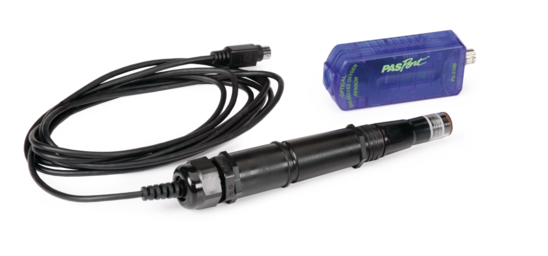Optical Dissolved Oxygen Sensors
Dissolved oxygen (DO) is a crucial factor to measure in cell culture, but it often gets overlooked for different reasons.
Traditional DO probes can be cumbersome and not widely used.
However, there’s a simple solution available: Optical DO sensors.
These sensors rely on optics and have become more affordable for biomanufacturing teams. Unlike the older electrochemical DO sensors (Clark electrodes), optical sensors offer a more accessible and effective option.
They help monitor oxygen levels in laboratory cell culture, providing valuable information for better control and optimization.

Image Credit: PASCO
How do optical dissolved oxygen sensors work?
Optical DO sensors consist of two main components:
- A sensor spot
- A fiber optic reader.
The sensor spot is securely attached inside a cell culture vessel and contains a special fluorescent dye mixed in a hydrogel. Please note that only the sensor spot comes into contact with the cells or media being monitored.
On the other hand, the fiber optic reader is connected to a computer or data hub. Its role is to send and receive optical signals to and from the sensor spot. The optical DO sensors work by measuring the concentration of dissolved oxygen in liquid media or air.
This is done by observing the changes in luminescence caused by the presence of oxygen. Both the intensity and the lifetime of the luminescence can be used to accurately measure the dissolved oxygen levels.
There are three methods of measuring optical dissolved oxygen:
Magnitude domain measurement is a method of dissolved oxygen (DO) analysis that involves measuring the peak of luminescence, providing insights into the oxygen concentration.
Lifetime domain measurement focuses on analyzing the decay rate of luminescence, allowing for precise determination of DO levels.
Phase domain measurement evaluates the phase difference of the entire signal to accurately quantify the dissolved oxygen content in the sample.
Optical DO sensor technology is based on the principle that the luminescence of chemical dyes in the sensor is affected by dissolved oxygen. The sensor’s fluorophore is excited by a blue light emitted by the fiber optic reader, resulting in light emission at a higher wavelength.
In the presence of oxygen, the fluorescence is quenched, leading to changes in emission intensities and decay time, which are measured by the reader.
Lifetime domain-based sensors are preferred for their superior long-term accuracy, stability, and resistance to issues like leaching, dye degradation, and signal drift.
What are the benefits of optical DO sensors?
| Benefits | Details |
|---|---|
| No Flow Required | Optical sensors do not consume oxygen, eliminating the need for continuous oxygen supply at the sensor tip. This enables their use in static cell cultures. |
| Minimal Maintenance | Optical sensor spots are designed to be single-use, affordable, and disposable. With no membrane or cathode to replace, regular maintenance is required only over longer intervals, measured in months or years. |
| No Need for Calibration | High-quality optical DO sensors come pre-calibrated, eliminating the need for adjustments before use. This minimizes any potential downtime during experiments. |
| Short Response Time | Optical sensors exhibit a response rate similar to optical probes. Additionally, their extended measurement lifespan is an advantage as daily calibration is not necessary. |
What are the limitations of optical DO sensors?
| Limitations | Details |
|---|---|
| Sensor Spot Sensitivity | Optical sensor spots are small and delicate, requiring careful handling. They can be damaged when exposed to high concentrations of alcohols or certain organic compounds. |
| Entry Cost | While the lifetime cost of optical DO sensors is lower compared to other probe types due to replacement and maintenance, the initial cost is generally higher than that of electrochemical probes. |
| New Technology | Despite being discovered over 20 years ago, optical sensor technology is still relatively new in the market. Many users may not be familiar with how these sensors function. |
How do I use a lab-grade DO probe?
In a laboratory-grade DO probe, the key components include a PTFE membrane, a cathode, and an anode immersed in an electrolyte.
The probe operates by allowing O2 molecules to diffuse through the membrane, where they are subsequently reduced at the cathode, generating a small voltage.
The voltage reading corresponds to the concentration of O2 molecules present, with higher concentrations yielding higher readings. To obtain the voltage reading, you can simply use a multimeter or analog-to-digital converter, making it easy to measure and monitor DO levels.
One advantage of laboratory-grade DO probes is their ability to be fully submerged in both fresh and salt water without any limitations, ensuring reliable analytical measurements in various environments.
How do I use an industrial DO probe?
Industrial DO probes operate on the same principle as laboratory-grade probes but utilize a silicone membrane instead of a PTFE membrane.
When using an industrial DO probe, it can be connected to a DO circuit and an RTD circuit through a carrier board. In industrial processes, the DO probe can be connected to a DO transmitter for more advanced functionality.
Similar to their laboratory-grade counterparts, industrial DO probes are designed to withstand full submersion in both fresh and salt water without limitations. They can remain submerged indefinitely up to the tinned lead connector, ensuring reliable and continuous monitoring in industrial settings.
What can affect dissolved oxygen in water?
When conducting measurements of dissolved oxygen, please consider various factors that can influence the accuracy and reliability of the readings.
Some of the key factors to consider are:
| Factor | Impact on Dissolved Oxygen Measurements |
|---|---|
| Temperature | As water temperature increases, the solubility of oxygen decreases, leading to lower dissolved oxygen levels. Monitoring and compensating for temperature changes is crucial for accurate measurements. |
| Salinity | Higher salinity levels can reduce the solubility of oxygen, affecting dissolved oxygen readings. Consideration of salinity variations is important, particularly in marine or brackish water environments. |
| Barometric Pressure | Changes in barometric pressure can influence the solubility of gases, including oxygen. Accounting for barometric pressure fluctuations is necessary for accurate dissolved oxygen measurements. |
| Humidity | High humidity levels can indirectly impact the accuracy of sensors and instruments used for dissolved oxygen measurement. Consideration of humidity is important for reliable measurements. |
It is advisable to minimize the impact of humidity by ensuring proper calibration and maintenance of the equipment.
Summary
The dissolved oxygen probe operates based on the principle of oxygen diffusion through a membrane into the sensor. As oxygen enters the sensor, it undergoes a chemical reduction process, generating an electrical signal. This signal is detected and measured by the dissolved oxygen probe, and the corresponding oxygen concentration is displayed on the meter or monitoring device.
I hope you like above blog. There is no cost associated in sharing the article in your social media. Thanks for reading!! Happy Learning!!

